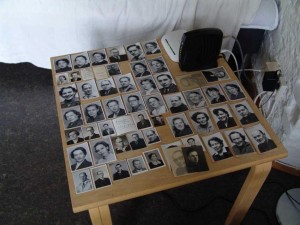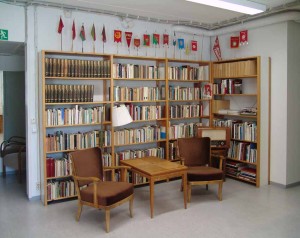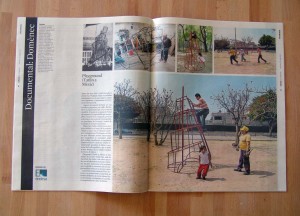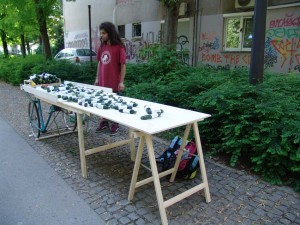Nowhere, in rhetorical terms, means belonging to modernity, the utopian space. Situated always beyond the horizon, in perpetual transformation, nowhere may never be reached; in reality, this is no destination, but rather a dream to stretch the present, so today isn’t today either, but rather an episode controlled by nowhere. It has been rather vehemently stated that contemporaneity, to a certain extent, represents the moment modern beings joined adulthood, a place where they will no longer be subjected obediently to the hopeful future events which have entranced them so far. From this viewpoint, this account referring to nowhere has been one of the first to lose credibility. It is here and now where the sense of experience should be established; yet, of course, the present itself, due to the aforementioned modern inheritance, has no real contingence, either. This is no solid place, capable of being the foundation of a project, but rather any place – right here. These are the latest news reports to arrive from nowhere, those placing it, indifferently, Ici même.
Ici même (Dins de casa), (Right Here (At Home)) one of the latest projects conceived by Domènec, comprises the full range of problems gliding in the background of his works in recent years; In this direction, we meet again with his insistent critical visits paid to modern paradigms – above all in the line of architecture – to show in these their weakness; but, besides, it may seem possible for us to see a highly important added value in this project between the lines of this: the chance to formulate the same objections and reprimands aimed at modernity on top of the outline of the post experience. The result is an overwhelming harshness: contemporaneity is no longer both the conquered freedom placed upon the denouncement of modern myths, and simple acceptance of the lack of such itself, but now has no camouflage. Contemporary experience is thus the bloody paradox which turns freedom into an oppressive condition.
Let us make the proposal of advancing orderly to approach all these issues. First, let us attempt to highlight the real thread of Domènec’s latest projects: a review of modern models with an attitude of simultaneous fascination and deconstruction; later we shall be in more optimum conditions to verify to what extent the work titled Ici même (Dins de casa), despite Le Corbusier’s significant quotation, where the real contemplation revolves around the post-modern alternatives, which, as was mentioned earlier, far from modifying the analysis concerning modern news reports, enables us to highlight the same type of lacking even more.
1.
As has been noted widely and in vastly different areas, contemporary culture has been practically forced to substitute the principle of genuine creation or production, for reading and interpretation. All speech preserves the gossip of a previous text which turns it into a simple reading; and this, far from contributing to strengthen the presence of the original text as the hard core of language, what it has awoken is the awareness of the rhetorical nature of all languages. So – and I do not wish to insist on its description as it has been widely thematised – this has provoked especially dangerous reactions – at the cost of deculturalisation due to neo-theologies – those developed on a pluralist note. What I mean is that it is not odd in the least to come face to face with postulates, according to which, given their condition of being simple remarks from all discourses, no linguistic act is therefore a speech strong enough and interesting enough to be taken into consideration. Everything is permissible in the name of a malicious tolerance which, in actual fact, hides the apolitical message whereby nothing is important enough.
Naturally, the only possible reaction to this relativism and eclectic-like pluralism typical of the worst postmodernism, should not be able to consist of rescuing the myth from certain universal categories; Though it should, despite accepting the soft nature of thought, attempt to separate which texts are more interesting than others so as to, by reconsidering them, write a note-book of the present. In this difficult tessitura, contemporary culture has spoken out unequivocally and gone much farther beyond the innocuous aforementioned pluralism. These have been perfectly conscientious decisions, for example, to reread the philosophy from the school of suspicion as an alternative to the invitations to remain in the wake of metaphysics; or dislocate the tradition of architecture from the rationalist register with all the power of pre-modern architecture; or dampen the optimism of the visual avant-garde with the deconstruction of its illusions or, among many other operations, rescue as prototypically modern the pure literature which grows under the shadow of Flaubert or Mallarmé and even Robert Walser. It is precisely because of the direction of all these decisions that the short-sighted analysts from the academia have «discovered» that the real genealogy of post-modernity lies at the heart of modern culture. We have already mentioned this above: it may not be really such new and strident –almost frivolous- post-modernity, but actually a current modern inexpressive present in the modern-post style.
Domènec’s work in recent years should be interpreted, above all, from this perspective. It is true that his work – and even more so if we add all his earlier works with a more object-like nature to his latest projects –can also be read easily while exercising the traumatising of minimalist tradition, but this key to the reading, if it is developed, leads us to certain conclusions which are close to those earlier co-ordinates of interpretation. Minimalism, indeed, has been revisited by contemporary art with the aim of showing that all that purity and ideal concerning neutrality was an illusion which could be cracked with absolute ease if one began to put those hypothetical cases in their place as pure objects in the context of social, historical or narrative order. And what is more important and odd about all this process is that contemporary art has recovered all these parameters (such as research concerning reality, history or fiction) as if they were the fundamental ingredients of its speculation, precisely due to contemplating and reconsidering minimalist objects. To say this somewhat more directly: when the minimalist tradition erects a neutral aesthetic object, thus a series of strategies is set up to reconsider the conditions of reality of that object and in the deployment of these strategies the basic map of contemporary art is drawn up.
The more or less intermittent references made by contemporary culture in the architecture of the modern movement, of course, must be read from the post situation which critically assesses emancipating utopias given the fact that architecture, due to its obvious condition, represents the most elaborate model of those aims; but it is also true that, in the world of contemporary art, the use of modern architecture must be interpreted with an added value: it also represents a strategy for submitting the aims of minimalism to the conditions of reality. It is in this way that two lines of research are built rather easily which, despite the obvious differences, in reality, bear a powerful relationship …In any case –from one way or the other, or from the whole of both as Domènec’s work could be represented –this appeal to the modern movement’s architecture acts as reliable proof regarding the hierarchy of certain accounts so as to feed the remarks which constitute the present.
In Domènec’s case, this reading of the modern tradition of architecture is clearly visible; Alvar Aalto is clearly present in 24 hores de llum artificial (Twenty-four hours of artificial light) and Le Corbusier in Un lloc (A Place) and the aforementioned Ici même (dins de casa). The direction of this review also becomes directly explicit: on turning the warm and comfortable interiors of a hospital in Paimio into an artificial and unbreathable space; or when reducing such a paradigm as l’unité d’habitation into a piece of furniture in an impersonal room or into the motive of an advertising image, the whole of modern utopia is reduced to a nightmare. All these pieces are, above any other consideration, the construction of specific areas; but it is obvious that the foundations of these works finish up in this harrowing irony – in the Beckett-like nature we have mentioned on earlier occasions – with which the reference point of modern architecture is used.
In the case of the latest work, Ici même (dins de casa), the creation of a willingly equivocal climate around the work of Le Corbusier is highly emphasised. Firstly, in the meaning of the firmness that unhesitatingly turning the most optimistic and humanist aims of modernity– and l’unité d’habitation is such – into a vulgar advertising message; but the crudeness is emphasised even more so if we add to this pitifully insignificant new condition of the alleged canon, by turning it into archaeological remains, a remote ruin swallowed up by nature.
Modern aims of fitting out a truly inhabitable place, embedded in the projects of Aalto or Le Corbusier, are damaged in their contemporary deconstruction, highlighting the fact that they merely serve to provide a promise of a useless future for the experience of here and now.
2.
In a general and indeed panoramic way, this same recrimination towards the modern movement based on an excessively anticipatory conception of architecture – whereby it was supposed that certain previous formal guidelines should be enough to guarantee the happiness coming from the experience to be developed inside these shapes – is what has led research on contemporary architecture to the land of the event, of the greatest versatility of shapes and functions and, even, to the more or less explicit recovery of clearly pre modern notions and types – the idea of the picturesque or pavilions – leaning more towards the conception of architecture as an available space, of a flexible nature, capable of acting like a container of situations, experiences and multiple uses. Ici même (dins de casa), as we have attempted to explain, is a project which, along the lines as the earlier works made and based on Alvar Aalto or Le Corbusier himself, clearly exemplifies that critical conclusion of modern items; but way beyond this, it highlights a review up to the contemporary alternatives themselves. In the first instance, and given the fact that it involves a life-size bus shelter for waiting at a station, the project is offered as a space for occasional use, absolutely ephemeral and concerning wasted time; on the other hand, its hypothetical use leads us to mobility and covering distances; from another register, we could even interpret this peculiar area as a kind of pavilion in the same perspective we mentioned before. The change of scenery as regards earlier projects is thus evident; we are no longer reading a story organised according to the typically modern principle of a life which is focused, illuminated and becomes sedimentary but rather the complete opposite, now all that universe of values has been substituted by a number of parameters more in line with the late correction of that modern myth. The built area is now a space to be used in the most practical sense of the word, devoid of any pretentious ontological nature and, in its place, with an outline of a nature much more emphatically experimental. In light of this, it seems that we find ourselves with a project which has invented the optimum conditions to reinforce its objections to the modern account; but, in reality, the most interesting thing is that the ontologically weak character of the new post architecture is not used to facilitate opposition to Le Corbusier but to submit it to critical reading itself.
Having reached this point we should be rather careful about how we consider the question. We are not reducing the problem to a simple statement, according to which, the only difference between modern dreams and the contemporary horizon consists of the fact that the former aims to build a home and fails in the attempt, while nowadays, far from clearing up the procedure by which we could satisfactorily achieve the same dream, what we actually do is accept that condition of inclemency. All this actually floats around behind the whole series of Domènec’s projects which leads us to Ici même (dins de casa). In this, his latest project there persists an emphasis on the impossibility of establishing a living space in a complete sense; the idea of home – specified, as on other occasions, in the title itself – again showing its weakness when it becomes awkward shelter – a shed- which, on the other hand, could never fulfil the prospects of being a personal place, but rather, imposes its condition of being a place where strangers are doomed to meet each other. All this, shall we say, is indeed present in this project, but the most important thing, to say this in short, is that it appears to be based on a post space –not utopian any more but weak –which is also submitted to its own peculiar deconstruction and which, in this operation, instead of being celebrated as a space which is easy to handle and experimental, what is acknowledged is the ease in which the contemporary experience becomes perverted into an absolutely banal experience.
The mosaic of all the elements entering into this game is already laid down. The sequence we are attempting to organise would be like this: first it would be necessary to introduce a correction for formal ideals which guide and predetermine experience as, far from their pretensions, never managed to construct a space for happiness. This is what 24 hores de llum artificial (24 hours of artificial sun), Un lloc (A Place) or the photograph of the bus shelter in his latest work show. The second moment consists of adapting other models that are more inclined towards the unforeseeable value of the use of space and the construction of meaning based on real experience; Certain co-ordinates which do not allow a conventional home to be built either, but which at least respond to nature itself diffused of things. This is what drives the development of Ici même (dins de casa) based on a post construction, such as the pavilion represented by the bus shelter. The last episode begins when this kind of spatial alternative which hoards the value of the possibility of being used and of being a real experience, when being deconstructed, shows that, nowadays, the only real experience is that of absolute banality. In Ici même (dins de casa) this latter idea – that which is still not shown, banality- we think is expressed clearly in reducing the experience capable of containing the bus shelter into one possibility only: to be an experience of advertising and pause.
The shelter, given the fact of its typology and hypothetical function, is offered as a public space. In its condition of being a real space – a vulgar urban bus shelter – and being such a space for public use, is decorated likewise by a lighted box suitable for advertising. The image in question is one which makes the l’unité d’habitation appear as if it were a mysterious real estate promotional activity which, when read carefully, would invoke everything we have set out in the first part of this text; but beyond these tones which lie behind the image, it is obvious that only a religious obedience may be kept with this. It is such a technologically mediated image however it is considered, but its light and arrangement- an altar-, is the typical advertising image is absolutely aura-like before which we are urged to develop the real, the true, contemporary public activity: shopping. This is what is left of the world of experience.
From a viewpoint quite close to the one above, the only use that can be made of this area, apart from using it to become acquainted with advertising messages, is to use it in a totally negative way. It is no longer the aim of trying to substitute constructive activity so full of promise which praises modern morale due to a more occasional, ephemeral action, but with the value of liveliness and authenticity. In this shelter time is, put simply, inactivity; it is the pause of waiting for a bus that doesn’t exist, wasted time. The shelter is a low area, a low intensity space and not, as we may suppose from an easily post-modern rhetoric, a hot space due to its open availability. The atmosphere again becomes, as in other works, that of a pause; the same tempo of monotonous and absurd rhythm which hammers us, due to the praise of the everyday gesture, in the video With the cold inside home.



